Management Accounting Report: Nisa's Financial Performance Analysis
VerifiedAdded on 2020/11/12
|20
|5143
|391
Report
AI Summary
This report provides a comprehensive analysis of management accounting principles and their application within Nisa, a leading UK retail chain. It begins with an introduction to management accounting, its types, and the specific systems that could be utilized by Nisa, such as cost accounting and inventory management systems. The report then explores various management accounting reporting methods, including accounts receivable aging, job cost reports, and cash flow analysis, highlighting their importance in business performance evaluation. Furthermore, the report delves into the production of income statements using both absorption and marginal costing techniques, illustrating the differences and advantages of each. The analysis extends to a discussion of different planning tools, outlining their pros and cons. Finally, the report addresses the adaptation of management accounting systems to respond to financial problems, culminating in a conclusion that summarizes the key findings and recommendations.
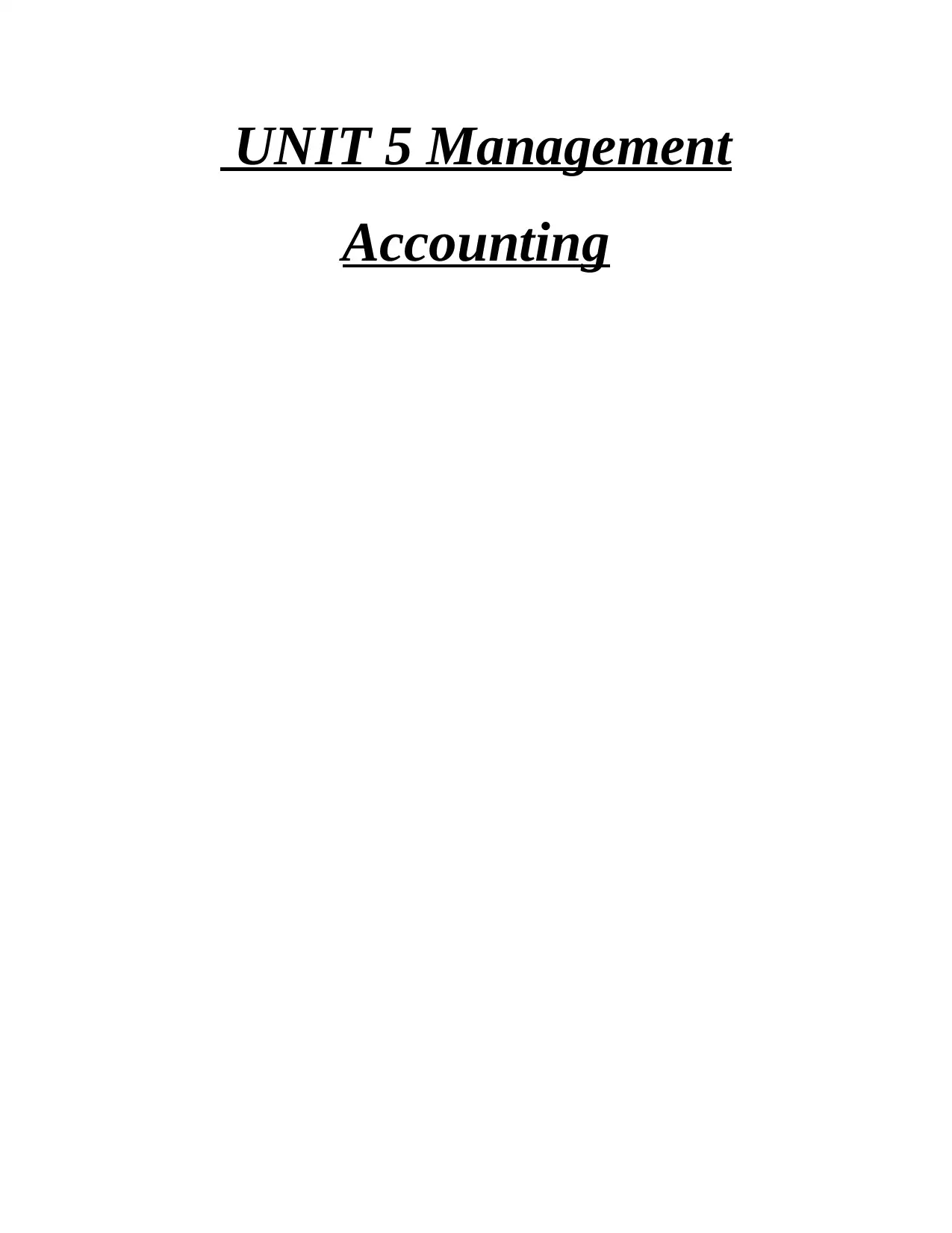
UNIT 5 Management
Accounting
Accounting
Paraphrase This Document
Need a fresh take? Get an instant paraphrase of this document with our AI Paraphraser
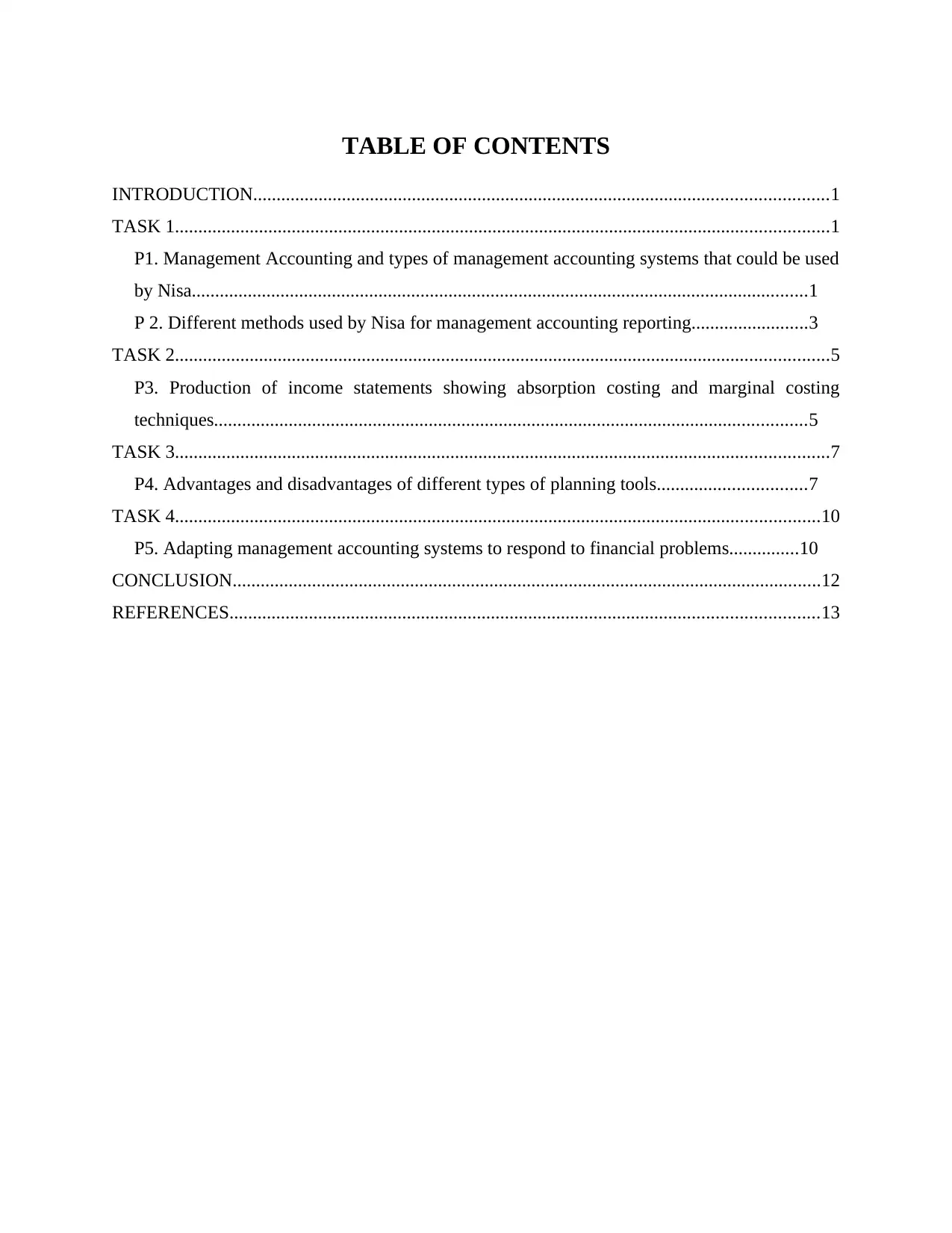
TABLE OF CONTENTS
INTRODUCTION...........................................................................................................................1
TASK 1............................................................................................................................................1
P1. Management Accounting and types of management accounting systems that could be used
by Nisa....................................................................................................................................1
P 2. Different methods used by Nisa for management accounting reporting.........................3
TASK 2............................................................................................................................................5
P3. Production of income statements showing absorption costing and marginal costing
techniques...............................................................................................................................5
TASK 3............................................................................................................................................7
P4. Advantages and disadvantages of different types of planning tools................................7
TASK 4..........................................................................................................................................10
P5. Adapting management accounting systems to respond to financial problems...............10
CONCLUSION..............................................................................................................................12
REFERENCES..............................................................................................................................13
INTRODUCTION...........................................................................................................................1
TASK 1............................................................................................................................................1
P1. Management Accounting and types of management accounting systems that could be used
by Nisa....................................................................................................................................1
P 2. Different methods used by Nisa for management accounting reporting.........................3
TASK 2............................................................................................................................................5
P3. Production of income statements showing absorption costing and marginal costing
techniques...............................................................................................................................5
TASK 3............................................................................................................................................7
P4. Advantages and disadvantages of different types of planning tools................................7
TASK 4..........................................................................................................................................10
P5. Adapting management accounting systems to respond to financial problems...............10
CONCLUSION..............................................................................................................................12
REFERENCES..............................................................................................................................13
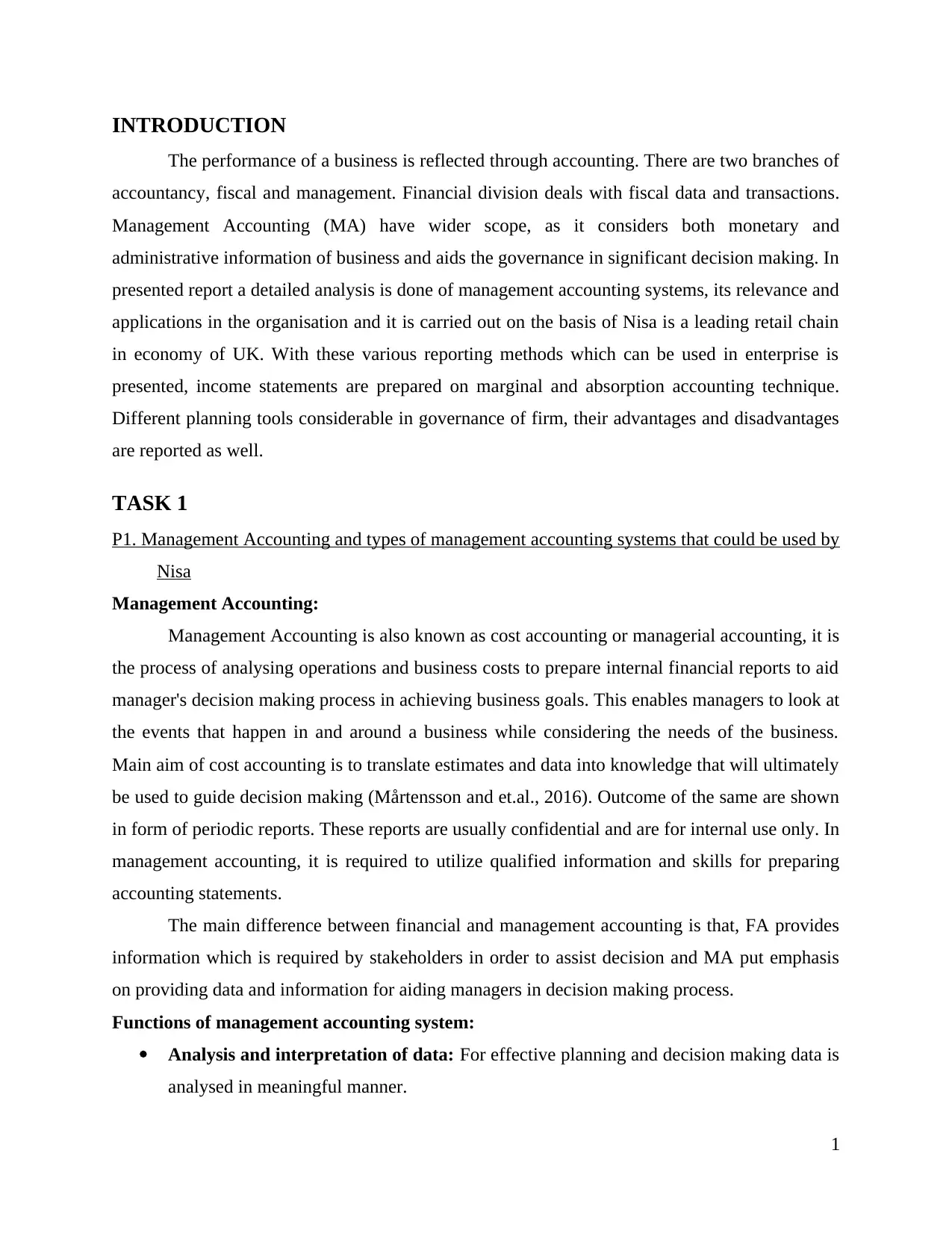
INTRODUCTION
The performance of a business is reflected through accounting. There are two branches of
accountancy, fiscal and management. Financial division deals with fiscal data and transactions.
Management Accounting (MA) have wider scope, as it considers both monetary and
administrative information of business and aids the governance in significant decision making. In
presented report a detailed analysis is done of management accounting systems, its relevance and
applications in the organisation and it is carried out on the basis of Nisa is a leading retail chain
in economy of UK. With these various reporting methods which can be used in enterprise is
presented, income statements are prepared on marginal and absorption accounting technique.
Different planning tools considerable in governance of firm, their advantages and disadvantages
are reported as well.
TASK 1
P1. Management Accounting and types of management accounting systems that could be used by
Nisa
Management Accounting:
Management Accounting is also known as cost accounting or managerial accounting, it is
the process of analysing operations and business costs to prepare internal financial reports to aid
manager's decision making process in achieving business goals. This enables managers to look at
the events that happen in and around a business while considering the needs of the business.
Main aim of cost accounting is to translate estimates and data into knowledge that will ultimately
be used to guide decision making (Mårtensson and et.al., 2016). Outcome of the same are shown
in form of periodic reports. These reports are usually confidential and are for internal use only. In
management accounting, it is required to utilize qualified information and skills for preparing
accounting statements.
The main difference between financial and management accounting is that, FA provides
information which is required by stakeholders in order to assist decision and MA put emphasis
on providing data and information for aiding managers in decision making process.
Functions of management accounting system:
Analysis and interpretation of data: For effective planning and decision making data is
analysed in meaningful manner.
1
The performance of a business is reflected through accounting. There are two branches of
accountancy, fiscal and management. Financial division deals with fiscal data and transactions.
Management Accounting (MA) have wider scope, as it considers both monetary and
administrative information of business and aids the governance in significant decision making. In
presented report a detailed analysis is done of management accounting systems, its relevance and
applications in the organisation and it is carried out on the basis of Nisa is a leading retail chain
in economy of UK. With these various reporting methods which can be used in enterprise is
presented, income statements are prepared on marginal and absorption accounting technique.
Different planning tools considerable in governance of firm, their advantages and disadvantages
are reported as well.
TASK 1
P1. Management Accounting and types of management accounting systems that could be used by
Nisa
Management Accounting:
Management Accounting is also known as cost accounting or managerial accounting, it is
the process of analysing operations and business costs to prepare internal financial reports to aid
manager's decision making process in achieving business goals. This enables managers to look at
the events that happen in and around a business while considering the needs of the business.
Main aim of cost accounting is to translate estimates and data into knowledge that will ultimately
be used to guide decision making (Mårtensson and et.al., 2016). Outcome of the same are shown
in form of periodic reports. These reports are usually confidential and are for internal use only. In
management accounting, it is required to utilize qualified information and skills for preparing
accounting statements.
The main difference between financial and management accounting is that, FA provides
information which is required by stakeholders in order to assist decision and MA put emphasis
on providing data and information for aiding managers in decision making process.
Functions of management accounting system:
Analysis and interpretation of data: For effective planning and decision making data is
analysed in meaningful manner.
1
⊘ This is a preview!⊘
Do you want full access?
Subscribe today to unlock all pages.

Trusted by 1+ million students worldwide
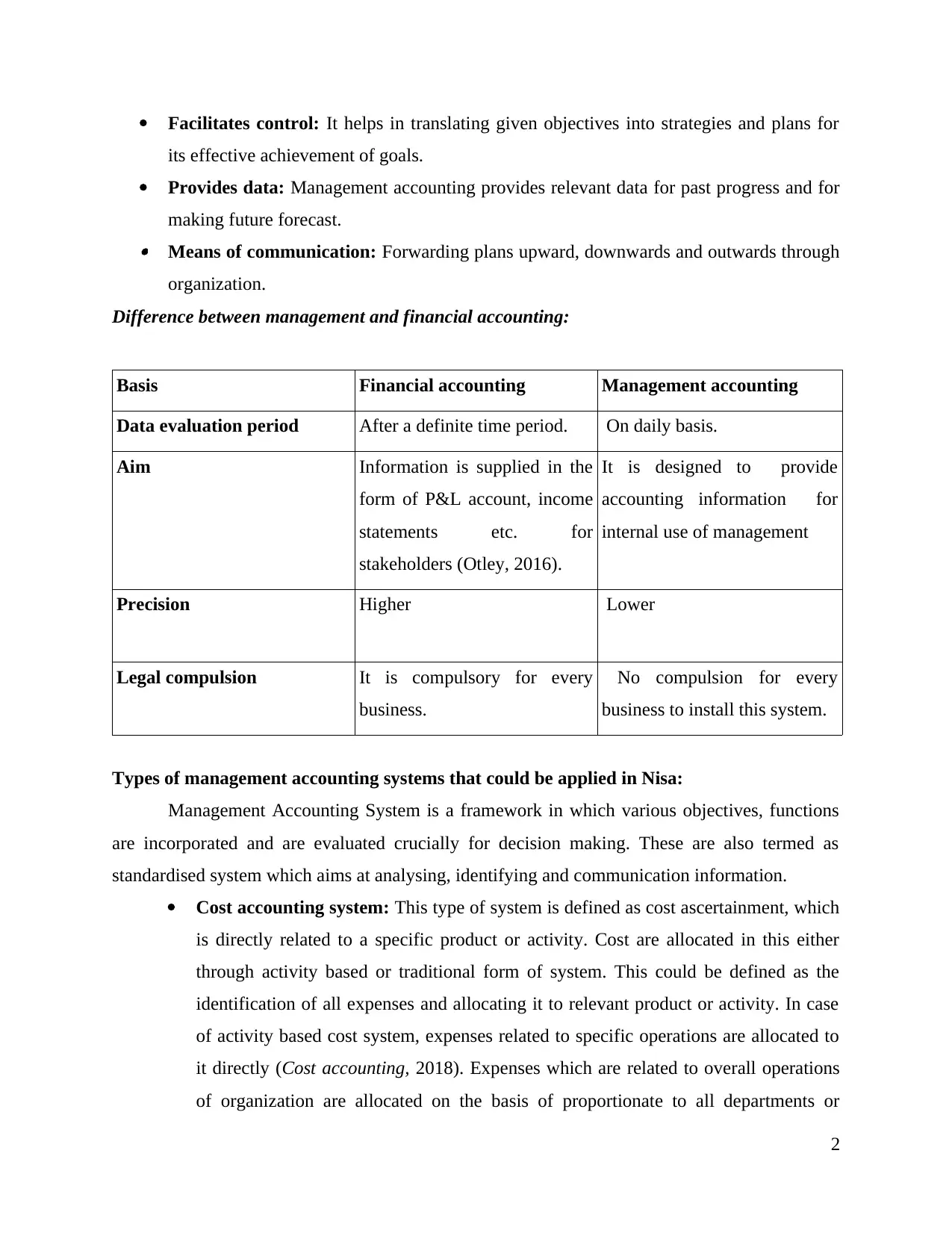
Facilitates control: It helps in translating given objectives into strategies and plans for
its effective achievement of goals.
Provides data: Management accounting provides relevant data for past progress and for
making future forecast. Means of communication: Forwarding plans upward, downwards and outwards through
organization.
Difference between management and financial accounting:
Basis Financial accounting Management accounting
Data evaluation period After a definite time period. On daily basis.
Aim Information is supplied in the
form of P&L account, income
statements etc. for
stakeholders (Otley, 2016).
It is designed to provide
accounting information for
internal use of management
Precision Higher Lower
Legal compulsion It is compulsory for every
business.
No compulsion for every
business to install this system.
Types of management accounting systems that could be applied in Nisa:
Management Accounting System is a framework in which various objectives, functions
are incorporated and are evaluated crucially for decision making. These are also termed as
standardised system which aims at analysing, identifying and communication information.
Cost accounting system: This type of system is defined as cost ascertainment, which
is directly related to a specific product or activity. Cost are allocated in this either
through activity based or traditional form of system. This could be defined as the
identification of all expenses and allocating it to relevant product or activity. In case
of activity based cost system, expenses related to specific operations are allocated to
it directly (Cost accounting, 2018). Expenses which are related to overall operations
of organization are allocated on the basis of proportionate to all departments or
2
its effective achievement of goals.
Provides data: Management accounting provides relevant data for past progress and for
making future forecast. Means of communication: Forwarding plans upward, downwards and outwards through
organization.
Difference between management and financial accounting:
Basis Financial accounting Management accounting
Data evaluation period After a definite time period. On daily basis.
Aim Information is supplied in the
form of P&L account, income
statements etc. for
stakeholders (Otley, 2016).
It is designed to provide
accounting information for
internal use of management
Precision Higher Lower
Legal compulsion It is compulsory for every
business.
No compulsion for every
business to install this system.
Types of management accounting systems that could be applied in Nisa:
Management Accounting System is a framework in which various objectives, functions
are incorporated and are evaluated crucially for decision making. These are also termed as
standardised system which aims at analysing, identifying and communication information.
Cost accounting system: This type of system is defined as cost ascertainment, which
is directly related to a specific product or activity. Cost are allocated in this either
through activity based or traditional form of system. This could be defined as the
identification of all expenses and allocating it to relevant product or activity. In case
of activity based cost system, expenses related to specific operations are allocated to
it directly (Cost accounting, 2018). Expenses which are related to overall operations
of organization are allocated on the basis of proportionate to all departments or
2
Paraphrase This Document
Need a fresh take? Get an instant paraphrase of this document with our AI Paraphraser
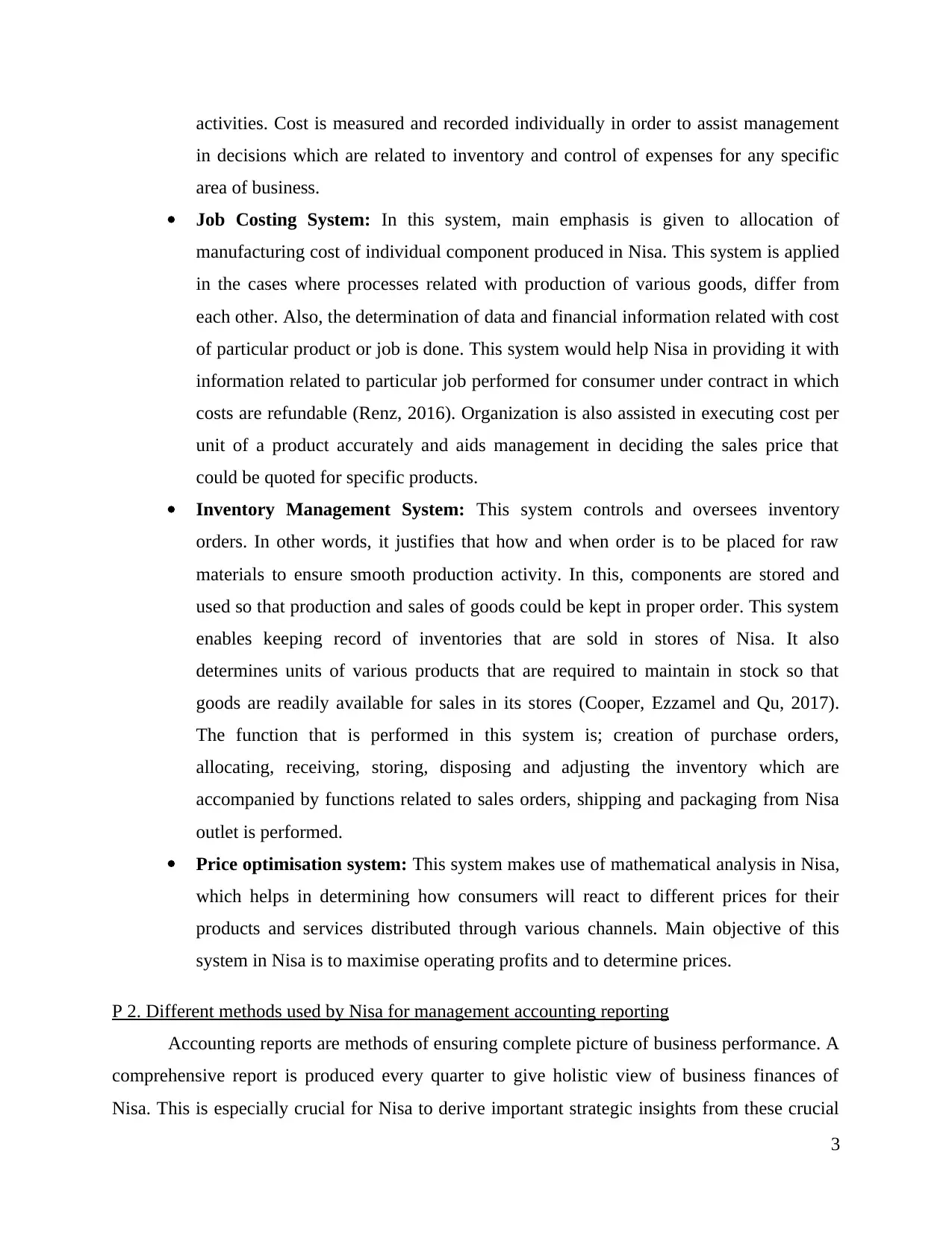
activities. Cost is measured and recorded individually in order to assist management
in decisions which are related to inventory and control of expenses for any specific
area of business.
Job Costing System: In this system, main emphasis is given to allocation of
manufacturing cost of individual component produced in Nisa. This system is applied
in the cases where processes related with production of various goods, differ from
each other. Also, the determination of data and financial information related with cost
of particular product or job is done. This system would help Nisa in providing it with
information related to particular job performed for consumer under contract in which
costs are refundable (Renz, 2016). Organization is also assisted in executing cost per
unit of a product accurately and aids management in deciding the sales price that
could be quoted for specific products.
Inventory Management System: This system controls and oversees inventory
orders. In other words, it justifies that how and when order is to be placed for raw
materials to ensure smooth production activity. In this, components are stored and
used so that production and sales of goods could be kept in proper order. This system
enables keeping record of inventories that are sold in stores of Nisa. It also
determines units of various products that are required to maintain in stock so that
goods are readily available for sales in its stores (Cooper, Ezzamel and Qu, 2017).
The function that is performed in this system is; creation of purchase orders,
allocating, receiving, storing, disposing and adjusting the inventory which are
accompanied by functions related to sales orders, shipping and packaging from Nisa
outlet is performed.
Price optimisation system: This system makes use of mathematical analysis in Nisa,
which helps in determining how consumers will react to different prices for their
products and services distributed through various channels. Main objective of this
system in Nisa is to maximise operating profits and to determine prices.
P 2. Different methods used by Nisa for management accounting reporting
Accounting reports are methods of ensuring complete picture of business performance. A
comprehensive report is produced every quarter to give holistic view of business finances of
Nisa. This is especially crucial for Nisa to derive important strategic insights from these crucial
3
in decisions which are related to inventory and control of expenses for any specific
area of business.
Job Costing System: In this system, main emphasis is given to allocation of
manufacturing cost of individual component produced in Nisa. This system is applied
in the cases where processes related with production of various goods, differ from
each other. Also, the determination of data and financial information related with cost
of particular product or job is done. This system would help Nisa in providing it with
information related to particular job performed for consumer under contract in which
costs are refundable (Renz, 2016). Organization is also assisted in executing cost per
unit of a product accurately and aids management in deciding the sales price that
could be quoted for specific products.
Inventory Management System: This system controls and oversees inventory
orders. In other words, it justifies that how and when order is to be placed for raw
materials to ensure smooth production activity. In this, components are stored and
used so that production and sales of goods could be kept in proper order. This system
enables keeping record of inventories that are sold in stores of Nisa. It also
determines units of various products that are required to maintain in stock so that
goods are readily available for sales in its stores (Cooper, Ezzamel and Qu, 2017).
The function that is performed in this system is; creation of purchase orders,
allocating, receiving, storing, disposing and adjusting the inventory which are
accompanied by functions related to sales orders, shipping and packaging from Nisa
outlet is performed.
Price optimisation system: This system makes use of mathematical analysis in Nisa,
which helps in determining how consumers will react to different prices for their
products and services distributed through various channels. Main objective of this
system in Nisa is to maximise operating profits and to determine prices.
P 2. Different methods used by Nisa for management accounting reporting
Accounting reports are methods of ensuring complete picture of business performance. A
comprehensive report is produced every quarter to give holistic view of business finances of
Nisa. This is especially crucial for Nisa to derive important strategic insights from these crucial
3
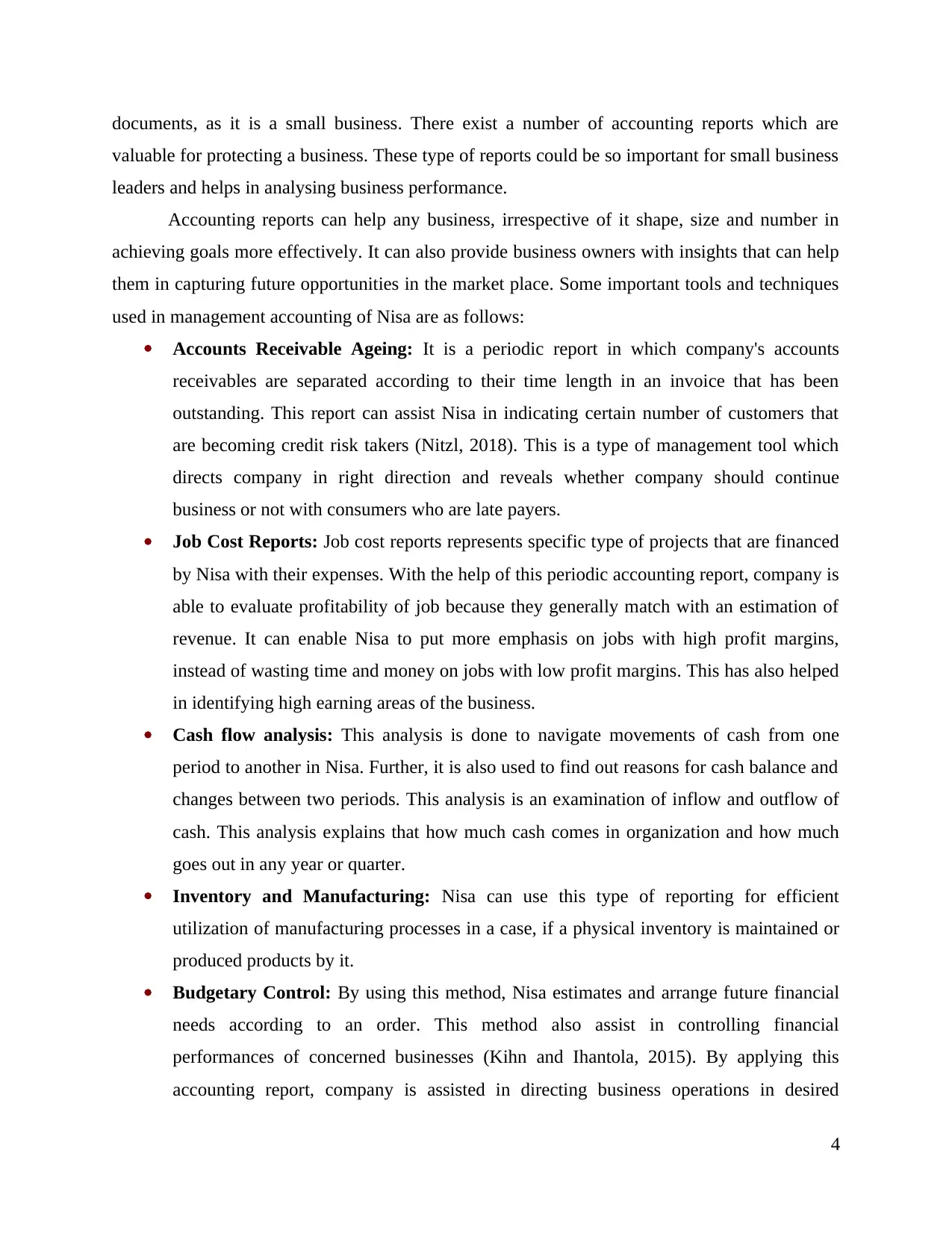
documents, as it is a small business. There exist a number of accounting reports which are
valuable for protecting a business. These type of reports could be so important for small business
leaders and helps in analysing business performance.
Accounting reports can help any business, irrespective of it shape, size and number in
achieving goals more effectively. It can also provide business owners with insights that can help
them in capturing future opportunities in the market place. Some important tools and techniques
used in management accounting of Nisa are as follows:
Accounts Receivable Ageing: It is a periodic report in which company's accounts
receivables are separated according to their time length in an invoice that has been
outstanding. This report can assist Nisa in indicating certain number of customers that
are becoming credit risk takers (Nitzl, 2018). This is a type of management tool which
directs company in right direction and reveals whether company should continue
business or not with consumers who are late payers.
Job Cost Reports: Job cost reports represents specific type of projects that are financed
by Nisa with their expenses. With the help of this periodic accounting report, company is
able to evaluate profitability of job because they generally match with an estimation of
revenue. It can enable Nisa to put more emphasis on jobs with high profit margins,
instead of wasting time and money on jobs with low profit margins. This has also helped
in identifying high earning areas of the business.
Cash flow analysis: This analysis is done to navigate movements of cash from one
period to another in Nisa. Further, it is also used to find out reasons for cash balance and
changes between two periods. This analysis is an examination of inflow and outflow of
cash. This analysis explains that how much cash comes in organization and how much
goes out in any year or quarter.
Inventory and Manufacturing: Nisa can use this type of reporting for efficient
utilization of manufacturing processes in a case, if a physical inventory is maintained or
produced products by it.
Budgetary Control: By using this method, Nisa estimates and arrange future financial
needs according to an order. This method also assist in controlling financial
performances of concerned businesses (Kihn and Ihantola, 2015). By applying this
accounting report, company is assisted in directing business operations in desired
4
valuable for protecting a business. These type of reports could be so important for small business
leaders and helps in analysing business performance.
Accounting reports can help any business, irrespective of it shape, size and number in
achieving goals more effectively. It can also provide business owners with insights that can help
them in capturing future opportunities in the market place. Some important tools and techniques
used in management accounting of Nisa are as follows:
Accounts Receivable Ageing: It is a periodic report in which company's accounts
receivables are separated according to their time length in an invoice that has been
outstanding. This report can assist Nisa in indicating certain number of customers that
are becoming credit risk takers (Nitzl, 2018). This is a type of management tool which
directs company in right direction and reveals whether company should continue
business or not with consumers who are late payers.
Job Cost Reports: Job cost reports represents specific type of projects that are financed
by Nisa with their expenses. With the help of this periodic accounting report, company is
able to evaluate profitability of job because they generally match with an estimation of
revenue. It can enable Nisa to put more emphasis on jobs with high profit margins,
instead of wasting time and money on jobs with low profit margins. This has also helped
in identifying high earning areas of the business.
Cash flow analysis: This analysis is done to navigate movements of cash from one
period to another in Nisa. Further, it is also used to find out reasons for cash balance and
changes between two periods. This analysis is an examination of inflow and outflow of
cash. This analysis explains that how much cash comes in organization and how much
goes out in any year or quarter.
Inventory and Manufacturing: Nisa can use this type of reporting for efficient
utilization of manufacturing processes in a case, if a physical inventory is maintained or
produced products by it.
Budgetary Control: By using this method, Nisa estimates and arrange future financial
needs according to an order. This method also assist in controlling financial
performances of concerned businesses (Kihn and Ihantola, 2015). By applying this
accounting report, company is assisted in directing business operations in desired
4
⊘ This is a preview!⊘
Do you want full access?
Subscribe today to unlock all pages.

Trusted by 1+ million students worldwide
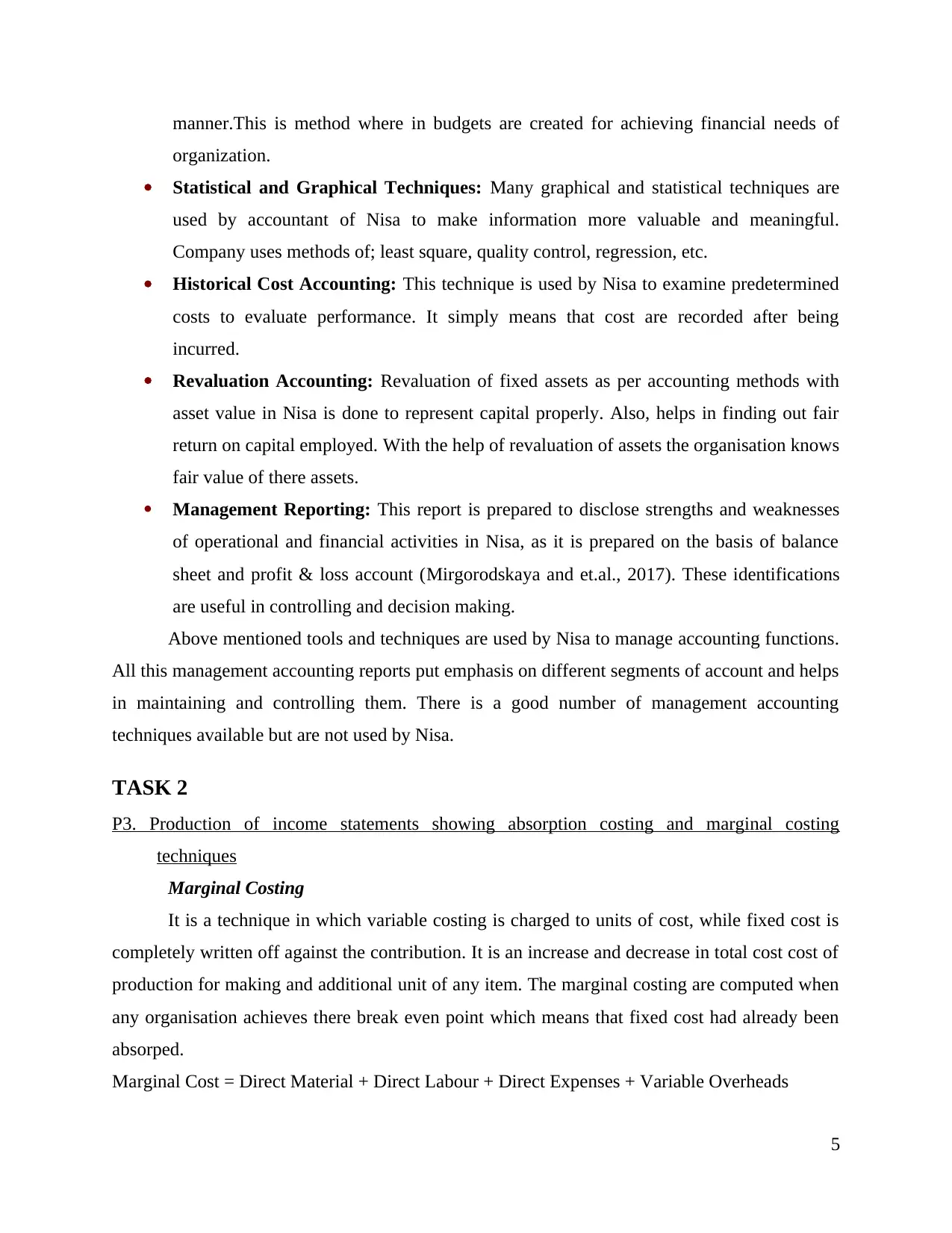
manner.This is method where in budgets are created for achieving financial needs of
organization.
Statistical and Graphical Techniques: Many graphical and statistical techniques are
used by accountant of Nisa to make information more valuable and meaningful.
Company uses methods of; least square, quality control, regression, etc.
Historical Cost Accounting: This technique is used by Nisa to examine predetermined
costs to evaluate performance. It simply means that cost are recorded after being
incurred.
Revaluation Accounting: Revaluation of fixed assets as per accounting methods with
asset value in Nisa is done to represent capital properly. Also, helps in finding out fair
return on capital employed. With the help of revaluation of assets the organisation knows
fair value of there assets.
Management Reporting: This report is prepared to disclose strengths and weaknesses
of operational and financial activities in Nisa, as it is prepared on the basis of balance
sheet and profit & loss account (Mirgorodskaya and et.al., 2017). These identifications
are useful in controlling and decision making.
Above mentioned tools and techniques are used by Nisa to manage accounting functions.
All this management accounting reports put emphasis on different segments of account and helps
in maintaining and controlling them. There is a good number of management accounting
techniques available but are not used by Nisa.
TASK 2
P3. Production of income statements showing absorption costing and marginal costing
techniques
Marginal Costing
It is a technique in which variable costing is charged to units of cost, while fixed cost is
completely written off against the contribution. It is an increase and decrease in total cost cost of
production for making and additional unit of any item. The marginal costing are computed when
any organisation achieves there break even point which means that fixed cost had already been
absorped.
Marginal Cost = Direct Material + Direct Labour + Direct Expenses + Variable Overheads
5
organization.
Statistical and Graphical Techniques: Many graphical and statistical techniques are
used by accountant of Nisa to make information more valuable and meaningful.
Company uses methods of; least square, quality control, regression, etc.
Historical Cost Accounting: This technique is used by Nisa to examine predetermined
costs to evaluate performance. It simply means that cost are recorded after being
incurred.
Revaluation Accounting: Revaluation of fixed assets as per accounting methods with
asset value in Nisa is done to represent capital properly. Also, helps in finding out fair
return on capital employed. With the help of revaluation of assets the organisation knows
fair value of there assets.
Management Reporting: This report is prepared to disclose strengths and weaknesses
of operational and financial activities in Nisa, as it is prepared on the basis of balance
sheet and profit & loss account (Mirgorodskaya and et.al., 2017). These identifications
are useful in controlling and decision making.
Above mentioned tools and techniques are used by Nisa to manage accounting functions.
All this management accounting reports put emphasis on different segments of account and helps
in maintaining and controlling them. There is a good number of management accounting
techniques available but are not used by Nisa.
TASK 2
P3. Production of income statements showing absorption costing and marginal costing
techniques
Marginal Costing
It is a technique in which variable costing is charged to units of cost, while fixed cost is
completely written off against the contribution. It is an increase and decrease in total cost cost of
production for making and additional unit of any item. The marginal costing are computed when
any organisation achieves there break even point which means that fixed cost had already been
absorped.
Marginal Cost = Direct Material + Direct Labour + Direct Expenses + Variable Overheads
5
Paraphrase This Document
Need a fresh take? Get an instant paraphrase of this document with our AI Paraphraser
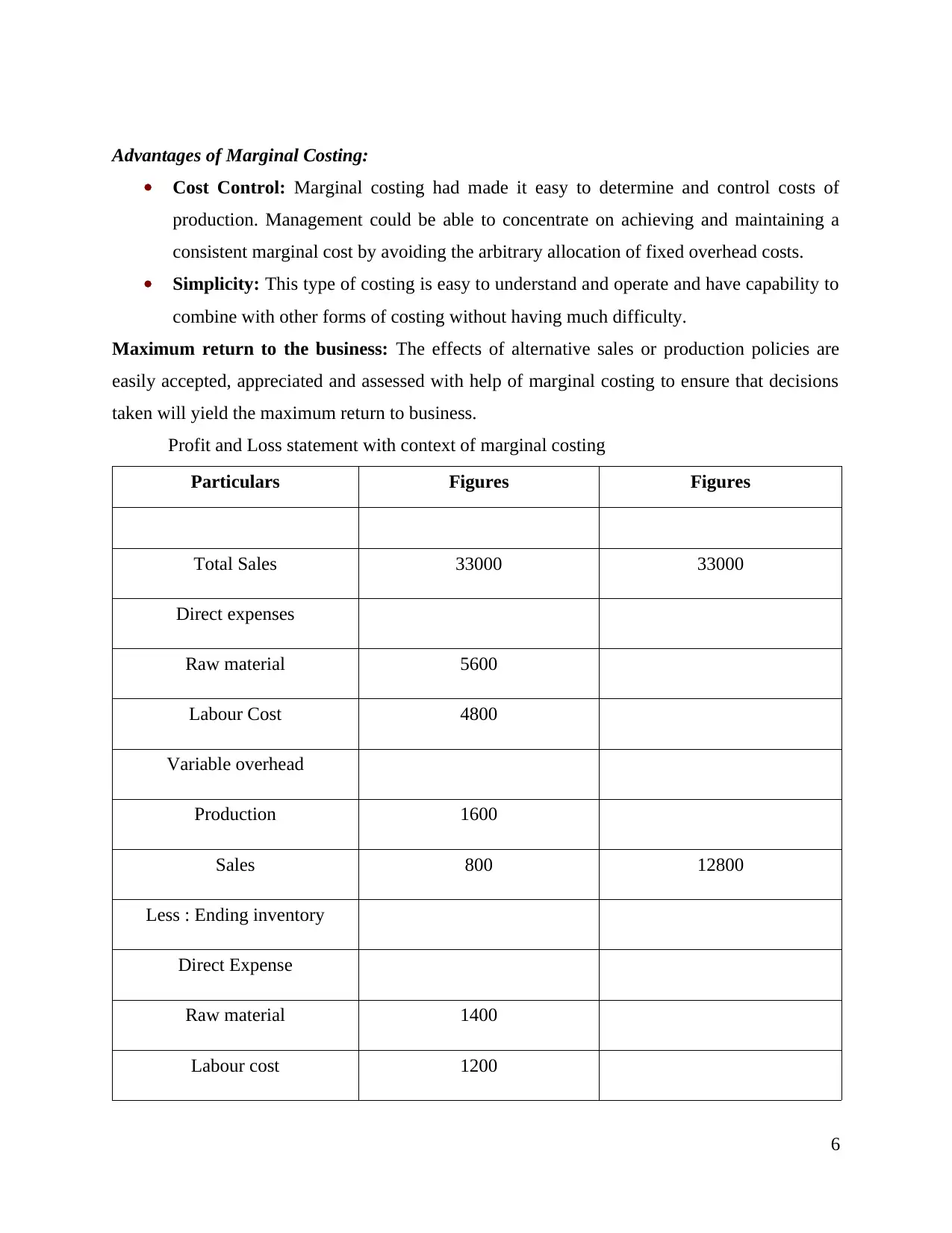
Advantages of Marginal Costing:
Cost Control: Marginal costing had made it easy to determine and control costs of
production. Management could be able to concentrate on achieving and maintaining a
consistent marginal cost by avoiding the arbitrary allocation of fixed overhead costs.
Simplicity: This type of costing is easy to understand and operate and have capability to
combine with other forms of costing without having much difficulty.
Maximum return to the business: The effects of alternative sales or production policies are
easily accepted, appreciated and assessed with help of marginal costing to ensure that decisions
taken will yield the maximum return to business.
Profit and Loss statement with context of marginal costing
Particulars Figures Figures
Total Sales 33000 33000
Direct expenses
Raw material 5600
Labour Cost 4800
Variable overhead
Production 1600
Sales 800 12800
Less : Ending inventory
Direct Expense
Raw material 1400
Labour cost 1200
6
Cost Control: Marginal costing had made it easy to determine and control costs of
production. Management could be able to concentrate on achieving and maintaining a
consistent marginal cost by avoiding the arbitrary allocation of fixed overhead costs.
Simplicity: This type of costing is easy to understand and operate and have capability to
combine with other forms of costing without having much difficulty.
Maximum return to the business: The effects of alternative sales or production policies are
easily accepted, appreciated and assessed with help of marginal costing to ensure that decisions
taken will yield the maximum return to business.
Profit and Loss statement with context of marginal costing
Particulars Figures Figures
Total Sales 33000 33000
Direct expenses
Raw material 5600
Labour Cost 4800
Variable overhead
Production 1600
Sales 800 12800
Less : Ending inventory
Direct Expense
Raw material 1400
Labour cost 1200
6
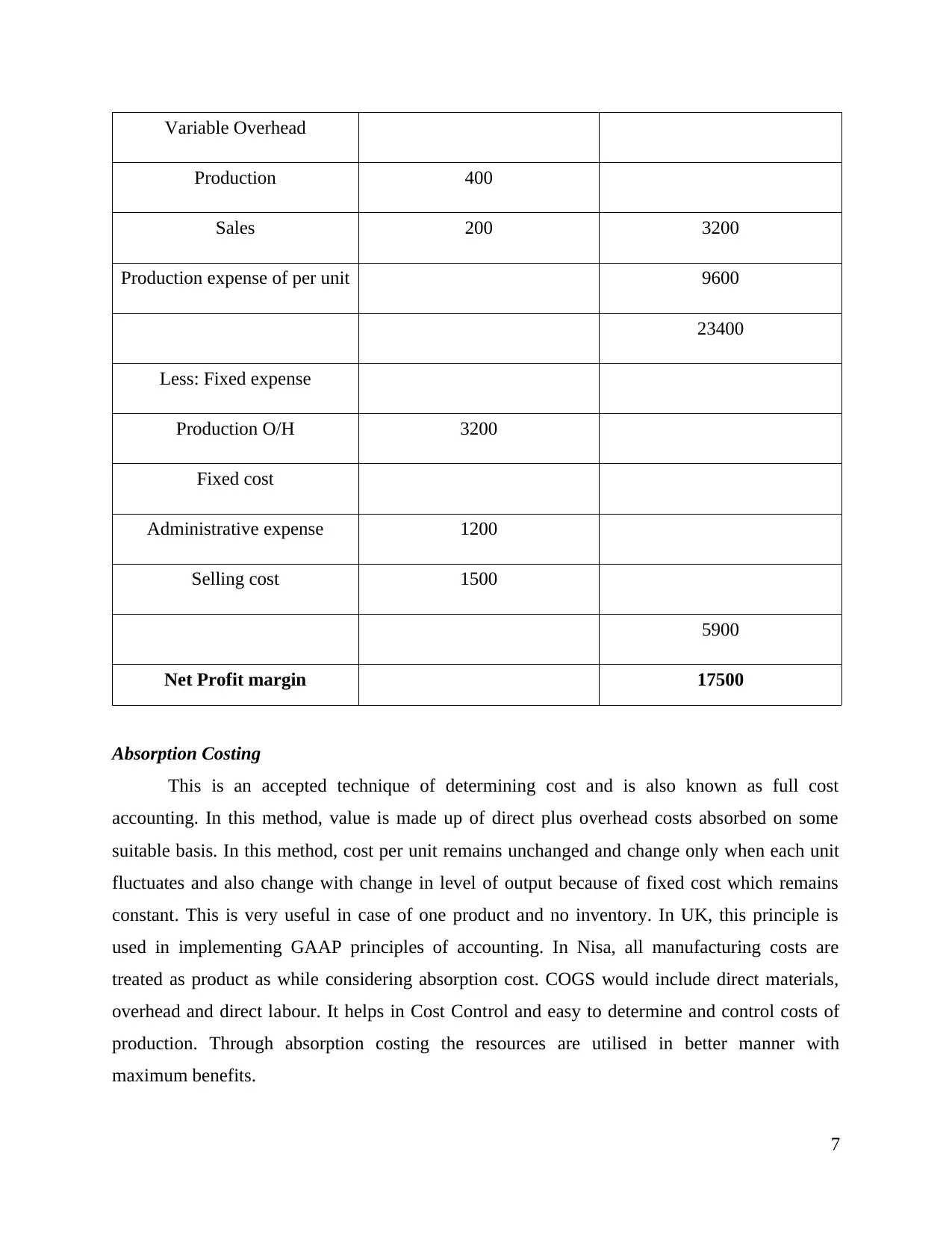
Variable Overhead
Production 400
Sales 200 3200
Production expense of per unit 9600
23400
Less: Fixed expense
Production O/H 3200
Fixed cost
Administrative expense 1200
Selling cost 1500
5900
Net Profit margin 17500
Absorption Costing
This is an accepted technique of determining cost and is also known as full cost
accounting. In this method, value is made up of direct plus overhead costs absorbed on some
suitable basis. In this method, cost per unit remains unchanged and change only when each unit
fluctuates and also change with change in level of output because of fixed cost which remains
constant. This is very useful in case of one product and no inventory. In UK, this principle is
used in implementing GAAP principles of accounting. In Nisa, all manufacturing costs are
treated as product as while considering absorption cost. COGS would include direct materials,
overhead and direct labour. It helps in Cost Control and easy to determine and control costs of
production. Through absorption costing the resources are utilised in better manner with
maximum benefits.
7
Production 400
Sales 200 3200
Production expense of per unit 9600
23400
Less: Fixed expense
Production O/H 3200
Fixed cost
Administrative expense 1200
Selling cost 1500
5900
Net Profit margin 17500
Absorption Costing
This is an accepted technique of determining cost and is also known as full cost
accounting. In this method, value is made up of direct plus overhead costs absorbed on some
suitable basis. In this method, cost per unit remains unchanged and change only when each unit
fluctuates and also change with change in level of output because of fixed cost which remains
constant. This is very useful in case of one product and no inventory. In UK, this principle is
used in implementing GAAP principles of accounting. In Nisa, all manufacturing costs are
treated as product as while considering absorption cost. COGS would include direct materials,
overhead and direct labour. It helps in Cost Control and easy to determine and control costs of
production. Through absorption costing the resources are utilised in better manner with
maximum benefits.
7
⊘ This is a preview!⊘
Do you want full access?
Subscribe today to unlock all pages.

Trusted by 1+ million students worldwide
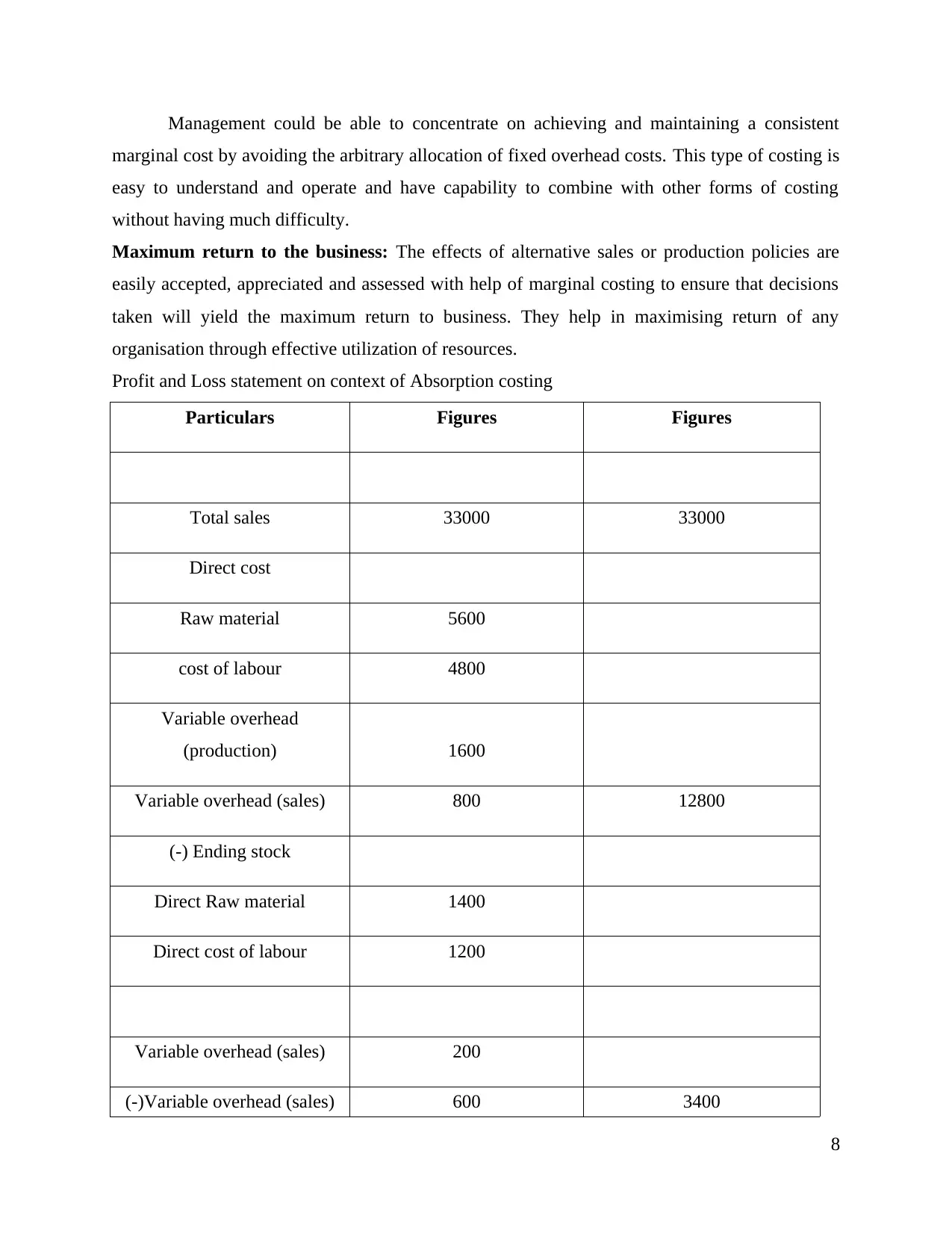
Management could be able to concentrate on achieving and maintaining a consistent
marginal cost by avoiding the arbitrary allocation of fixed overhead costs. This type of costing is
easy to understand and operate and have capability to combine with other forms of costing
without having much difficulty.
Maximum return to the business: The effects of alternative sales or production policies are
easily accepted, appreciated and assessed with help of marginal costing to ensure that decisions
taken will yield the maximum return to business. They help in maximising return of any
organisation through effective utilization of resources.
Profit and Loss statement on context of Absorption costing
Particulars Figures Figures
Total sales 33000 33000
Direct cost
Raw material 5600
cost of labour 4800
Variable overhead
(production) 1600
Variable overhead (sales) 800 12800
(-) Ending stock
Direct Raw material 1400
Direct cost of labour 1200
Variable overhead (sales) 200
(-)Variable overhead (sales) 600 3400
8
marginal cost by avoiding the arbitrary allocation of fixed overhead costs. This type of costing is
easy to understand and operate and have capability to combine with other forms of costing
without having much difficulty.
Maximum return to the business: The effects of alternative sales or production policies are
easily accepted, appreciated and assessed with help of marginal costing to ensure that decisions
taken will yield the maximum return to business. They help in maximising return of any
organisation through effective utilization of resources.
Profit and Loss statement on context of Absorption costing
Particulars Figures Figures
Total sales 33000 33000
Direct cost
Raw material 5600
cost of labour 4800
Variable overhead
(production) 1600
Variable overhead (sales) 800 12800
(-) Ending stock
Direct Raw material 1400
Direct cost of labour 1200
Variable overhead (sales) 200
(-)Variable overhead (sales) 600 3400
8
Paraphrase This Document
Need a fresh take? Get an instant paraphrase of this document with our AI Paraphraser
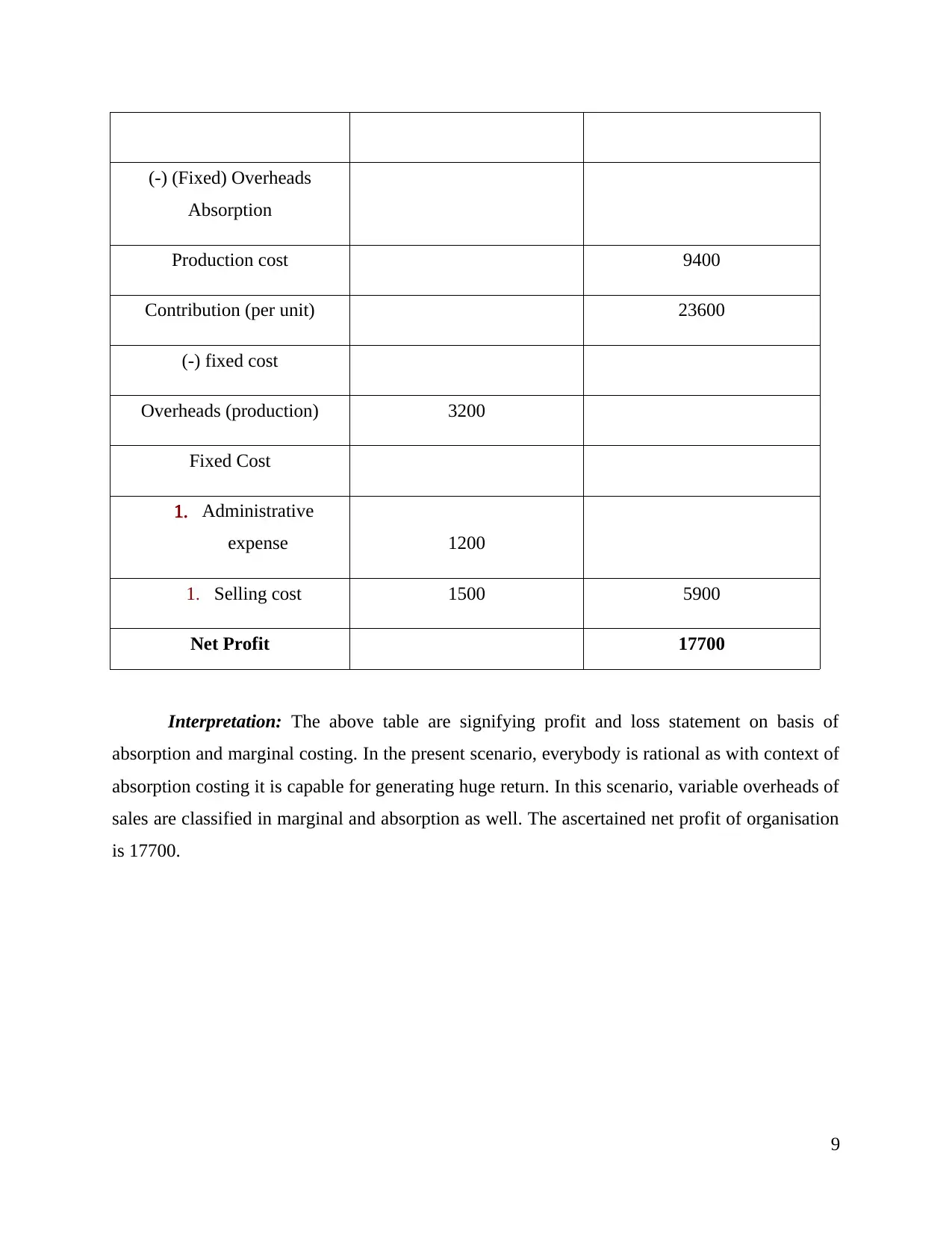
(-) (Fixed) Overheads
Absorption
Production cost 9400
Contribution (per unit) 23600
(-) fixed cost
Overheads (production) 3200
Fixed Cost
1. Administrative
expense 1200
1. Selling cost 1500 5900
Net Profit 17700
Interpretation: The above table are signifying profit and loss statement on basis of
absorption and marginal costing. In the present scenario, everybody is rational as with context of
absorption costing it is capable for generating huge return. In this scenario, variable overheads of
sales are classified in marginal and absorption as well. The ascertained net profit of organisation
is 17700.
9
Absorption
Production cost 9400
Contribution (per unit) 23600
(-) fixed cost
Overheads (production) 3200
Fixed Cost
1. Administrative
expense 1200
1. Selling cost 1500 5900
Net Profit 17700
Interpretation: The above table are signifying profit and loss statement on basis of
absorption and marginal costing. In the present scenario, everybody is rational as with context of
absorption costing it is capable for generating huge return. In this scenario, variable overheads of
sales are classified in marginal and absorption as well. The ascertained net profit of organisation
is 17700.
9
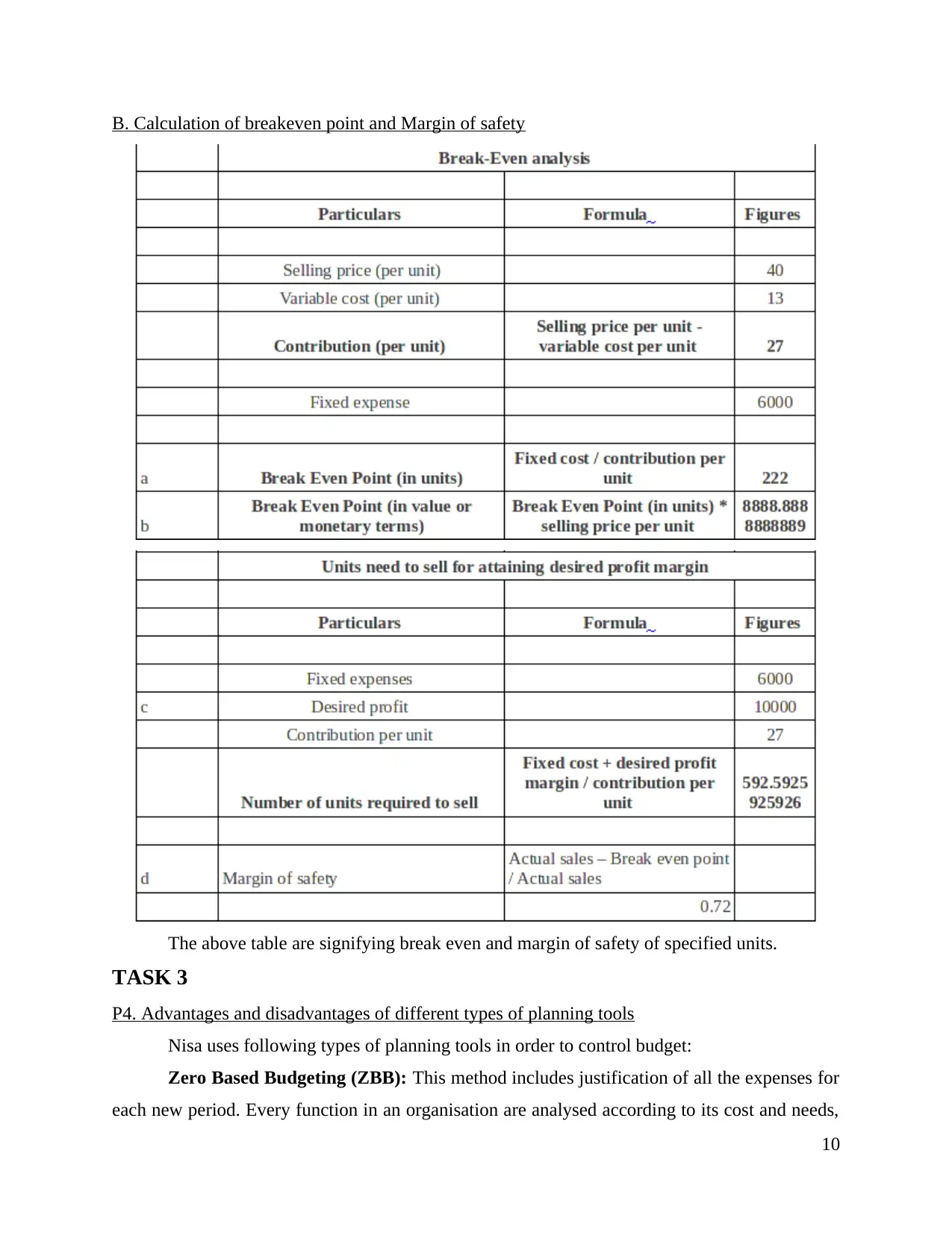
B. Calculation of breakeven point and Margin of safety
The above table are signifying break even and margin of safety of specified units.
TASK 3
P4. Advantages and disadvantages of different types of planning tools
Nisa uses following types of planning tools in order to control budget:
Zero Based Budgeting (ZBB): This method includes justification of all the expenses for
each new period. Every function in an organisation are analysed according to its cost and needs,
10
The above table are signifying break even and margin of safety of specified units.
TASK 3
P4. Advantages and disadvantages of different types of planning tools
Nisa uses following types of planning tools in order to control budget:
Zero Based Budgeting (ZBB): This method includes justification of all the expenses for
each new period. Every function in an organisation are analysed according to its cost and needs,
10
⊘ This is a preview!⊘
Do you want full access?
Subscribe today to unlock all pages.

Trusted by 1+ million students worldwide
1 out of 20
Related Documents
Your All-in-One AI-Powered Toolkit for Academic Success.
+13062052269
info@desklib.com
Available 24*7 on WhatsApp / Email
![[object Object]](/_next/static/media/star-bottom.7253800d.svg)
Unlock your academic potential
Copyright © 2020–2025 A2Z Services. All Rights Reserved. Developed and managed by ZUCOL.





